Kettlebells for Triathletes: Boost Strength, Endurance, and Performance
 Karen Parnell
January 17, 2025
Karen Parnell
January 17, 2025
Kettlebells for Triathletes: Boost Strength, Endurance, and Performance
If I had to pick one type of weight for training, it would be a kettlebell. Ever since my first kettlebell session on a Personal Training course, I was hooked. Back then, the course was full-time and face-to-face – an incredible sunny six weeks spent at the National Badminton Centre, training alongside Olympians!
It was there that I discovered just how versatile, efficient, and effective kettlebells can be.
In this article, I’ll share why kettlebells are an essential piece of kit for triathletes, explore their history, highlight their benefits, provide example workouts tailored to swimming, cycling, and running, and discuss different types of kettlebells you might consider.

Photo by Taco Fleur
Learn more about strength training for triathletes in our free e-book
What Are Kettlebells?
Kettlebells are cast iron or steel weights shaped like a cannonball with a handle on top. Originating in Russia in the 18th century, they were used as counterweights for measuring goods before evolving into tools for strength training and sport. The word “giryas” is the Russian term for kettlebells, and they became a staple in Russian military training due to their effectiveness.
Fast forward to today, kettlebells are a popular choice for athletes and fitness enthusiasts worldwide. Their unique design allows for dynamic, swinging movements that engage multiple muscle groups, offering a mix of strength, cardio, and mobility benefits in one tool.
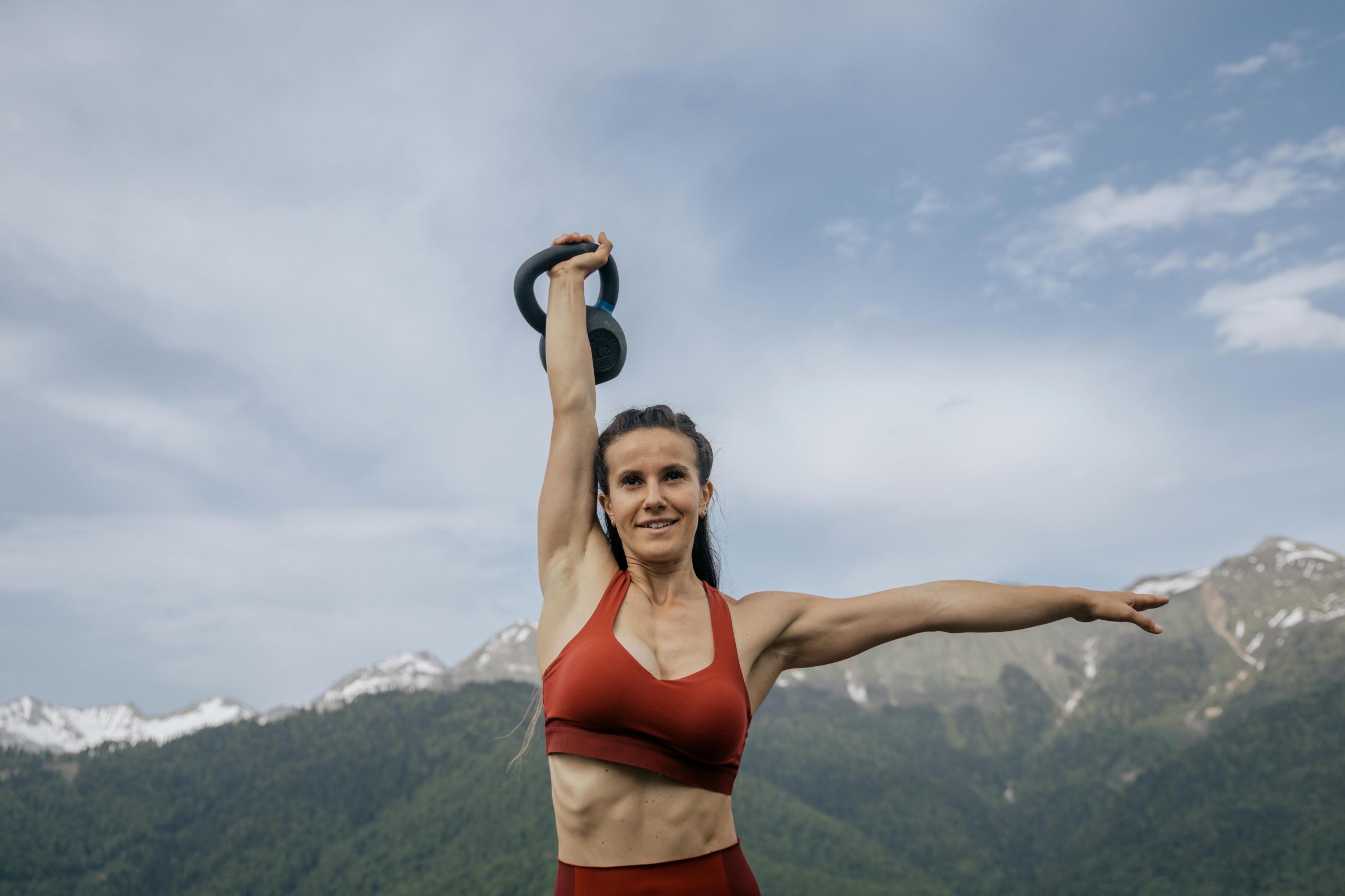
Photo by Anastasia Shuraeva
Learn more about strength training for triathletes in our free e-book
Benefits of Kettlebells for Triathletes
As a triathlete, your training needs to cover swimming, cycling, and running – disciplines that demand endurance, strength, coordination, and balance. Kettlebells can help you build all these attributes. Here’s how:
1. Full-Body Workouts
Kettlebell exercises engage multiple muscle groups simultaneously, helping you build functional strength that translates directly to triathlon performance. Movements like swings, cleans, and Turkish get-ups work your entire body, enhancing strength and coordination.
2. Core Stability and Balance
Every kettlebell workout challenges your core, which is essential for maintaining good posture while swimming, cycling, and running. Movements like the windmill or kettlebell plank rows improve your balance and stability, reducing the risk of injury.
3. Cardio and Strength Combined
Kettlebell training is time-efficient. High-intensity movements like kettlebell swings and snatches boost your cardiovascular fitness while building muscular endurance, mimicking the demands of a triathlon.
4. Improved Mobility and Flexibility
Exercises like goblet squats and arm bars help improve joint mobility and flexibility, which are crucial for efficient movement in all three triathlon disciplines.
The Global Triathlon Channel (GTN) agree with me and have selected six kettlebell moves that will help you become a stronger runner.
GTN Video: 6 Best Kettlebell Exercises To Make You A Stronger Runner
Learn more about strength training for triathletes in our free e-book
Kettlebell Exercise Moves for Triathletes
Here are some targeted kettlebell workouts to complement your swimming, cycling, and running training:
Kettlebell Exercises For Swimmers
- Single-Arm Kettlebell Row: Strengthens your lats and mimics the pulling motion of swimming. Perform 3 sets of 12 reps per arm.
- Turkish Get-Up: Enhances shoulder stability and mobility, crucial for efficient strokes. Aim for 3 reps per side.
- Halo: Works on shoulder mobility and core strength. Perform 3 sets of 10 circles in each direction.
Learn more about strength training for triathletes in our free e-book
Kettlebell Exercises For Cyclists
- Kettlebell Deadlift: Builds posterior chain strength for powerful pedalling. Perform 3 sets of 10 reps.
- Goblet Squat: Improves quad and glute strength, aiding hill climbs. Do 3 sets of 12 reps.
- Russian Twists: Strengthens obliques for better bike handling. Perform 3 sets of 20 twists (10 each side).
Learn more about strength training for triathletes in our free e-book
Kettlebell Exercises For Runners
- Kettlebell Swing: Develops explosive power and endurance. Perform 3 sets of 20 swings.
- Single-Leg Deadlift: Targets hamstrings and improves balance. Do 3 sets of 10 reps per leg.
- Suitcase Carry: Builds core strength and stability. Walk 30 meters per side for 3 rounds.
Learn more about strength training for triathletes in our free e-book
Quick and Effective 10 Minute Kettlebell Workout for Triathletes
Triathletes have to train for three disciplines as you know so after swim, bike and run training here can be little time to add more training on top but strength training should be non-negotiable.
Kettlebells over the ability to provide you with compact workouts you can do quickly but will hit pretty much every muscle you need as a triathlete.
This workout is simple, quick and effective. I love it and it can be modified as you get stronger by simply choosing a heavier kettlebell!
I started with 8kg when I first did this routine.
The workout is just three moves and can be thought of as a deconstructed burpee or "humane burpee" but don’t let this put you off!
You start with 15 kettlebell swings, 10 goblet squats then 10 push ups. The next round is 15 kettlebell swings, 9 goblet squats then 9 push ups. Continue for 10 rounds taking one off the squats and push ups but keeping the swings at 15.
Aim to cruise through the moves smoothly and with purpose, taking as few breaks as possible while maintaining good technique.
Warm up well and stretch after the workout.
If you have more time maybe do this as a pyramid? Start at 15 swings, 1 goblet squat and 1 push up. Work your way up to 15, 10, 10 then work back down as above.
This workout came from expert coach Dan John ‘every quality you want to chase is going to be in there somehow,’ he said. ‘You get sweaty, you get stronger, and you’re going to become a little bit more mobile too.’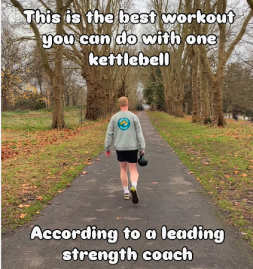
Learn more about strength training for triathletes in our free e-book
Types of Kettlebells
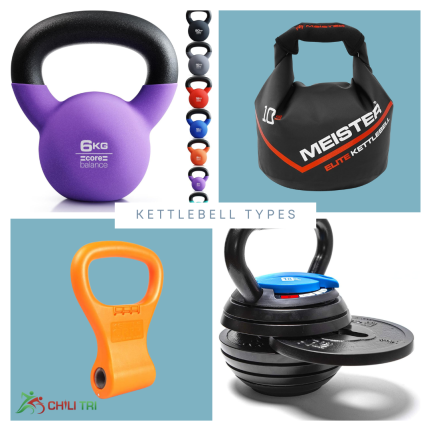
When choosing a kettlebell, you will find several options. Here are some to consider:
1. Cast Iron Kettlebells
These are the classic option, durable and available in various weights. They’re great for both beginners and advanced users.
These can be on the expensive side, and you will need to get several sizes for your workouts. Having a set of kettlebells will take up room so worth considering when looking at these. I would recommend 6kg, 8kg, 10kg, 12kg and 16kg kettlebells as a good range to start with.
I would recommend looking at ones with a neoprene coating to protect your floor like these from Amazon:
Cast Iron Core Balance Kettlebell Neoprene Coated
Amazon: £24.99 (6kg) to £69.99 (20kg)

2. Adjustable Kettlebells
Perfect for saving space, these allow you to adjust the weight, making them a versatile option for home workouts. A typical adjustable kettlebell ranges from 4kg to 18kg so will span the workouts you will do.
This is an example of an adjustable kettlebell from Braingain which can be adjusted from 4kg to 18kg.
BRAINGAIN 18kg Adjustable Kettlebell 7-in-1

3. Kettlebell Handles for Dumbbells
If you already own dumbbells, you can convert them into kettlebells using a specialized handle attachment. It’s an affordable and space-saving alternative. I have this here at my gym if I need to create a weight of kettlebell being used by another athlete. I have lots of dumbbells, so this is a great option to use what you already have.
Kettlebell Grip Adjustable Handle
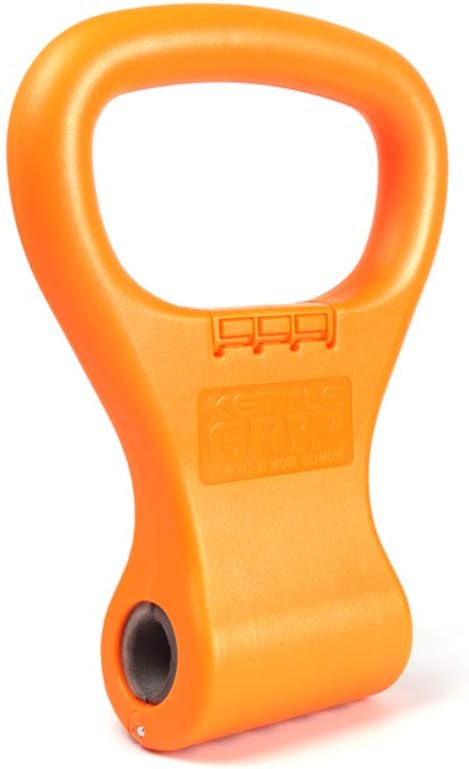
4. Sand-Filled Kettlebells
Ideal for travellers, these kettlebells can be packed flat and filled with sand or water upon arrival at your destination. You fill them to the weight you want. Great for maintaining your training routine on the go.
They are also cost effective and this one from Meister Elite can be used when filled with sand.
Meister Elite Portable Sand Kettlebell
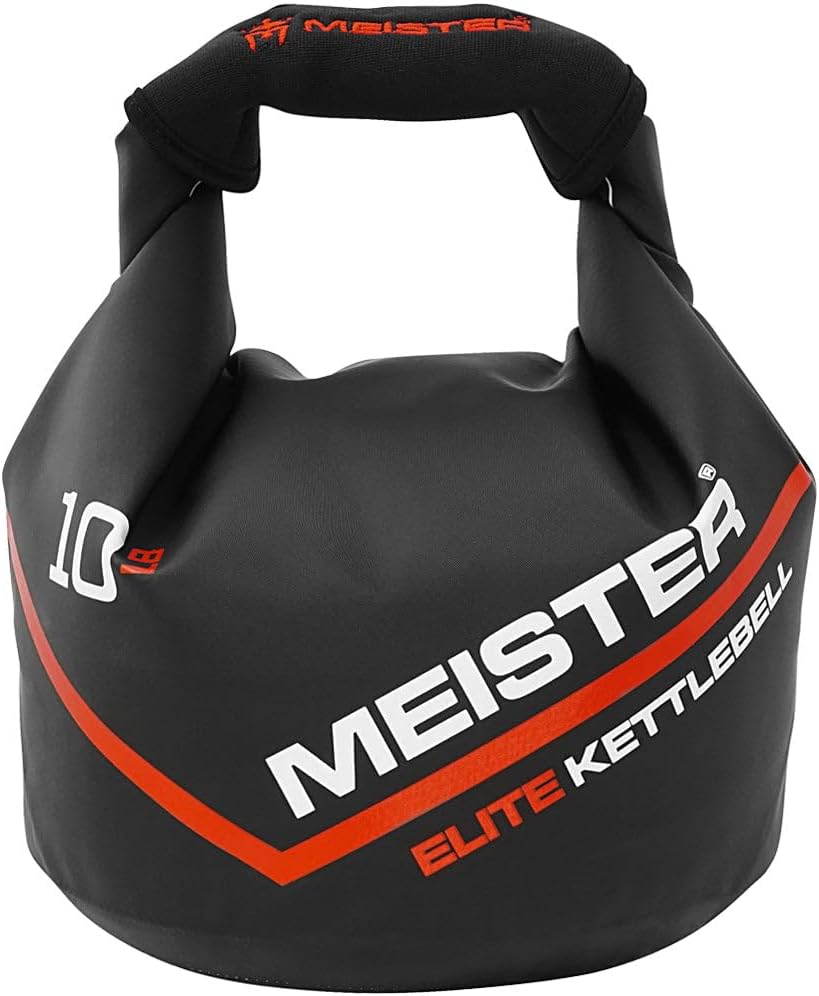
Learn more about strength training for triathletes in our free e-book
Conclusion: Kettlebell for Triathletes
If you’re a triathlete looking for a versatile, efficient, and effective training tool, kettlebells are a no-brainer. They offer full-body workouts, improve your core strength, boost endurance, and enhance mobility – all essential components for swimming, cycling, and running. Whether you’re training at home, at the gym, or even on the beach, there’s a kettlebell solution for you.
So, grab a kettlebell and start swinging your way to better triathlon performance. Your body will thank you at the finish line!
Before starting any kettlebell workout, it’s essential to master the basic movements to ensure proper form and avoid injury. If you’re unsure about your technique, seek guidance from a qualified professional who can help you perfect your form and stay safe during training.
Karen Parnell is a Level 3 British Triathlon and IRONMAN Certified Coach, 8020 Endurance Certified Coach, WOWSA Level 3 open water swimming coach and NASM Personal Trainer and Sports Technology Writer.
Karen has a post graduate MSc in Sports Performance Coaching from the University of Stirling.
Need a training plan? I have plans on TrainingPeaks and FinalSurge:
I also coach a very small number of athletes one to one for all triathlon and multi-sport distances, open water swimming events and running races, email me for details and availability. Karen.parnell@chilitri.com
Learn more about strength training for triathletes in our free e-book
Kettlebell FAQ for Triathletes
Are you a triathlete looking to enhance your training with kettlebells? This FAQ will address common questions and help you integrate kettlebells into your routine effectively.
1. What are the benefits of kettlebell training for triathletes?
Kettlebells offer numerous benefits, including:
- Full-body strength: Engages multiple muscle groups simultaneously.
- Core stability: Essential for swimming, cycling, and running.
- Cardio and strength combination: Improves endurance and power.
- Injury prevention: Enhances joint mobility and flexibility.
- Time efficiency: Allows for quick, effective workouts.
2. How often should I train with kettlebells?
For triathletes, 2-3 kettlebell sessions per week can complement your swim, bike, and run training. These sessions can be standalone strength workouts or added as short, high-intensity circuits on lighter training days.
3. What weight should I start with?
- Beginner triathletes: Start with 8-12kg for women and 12-16kg for men. Focus on mastering form before increasing weight.
- Experienced athletes: Progress to heavier weights (16-24kg) as you build strength and confidence.
4. Can kettlebells improve my swim performance?
Yes! Exercises like Turkish get-ups, single-arm rows, and halos target muscles used in swimming. They enhance shoulder stability, core strength, and mobility, which improve stroke efficiency and reduce injury risk.
5. How do kettlebells help with cycling?
Kettlebells strengthen the posterior chain (glutes, hamstrings, and lower back) and improve balance. Deadlifts, goblet squats, and swings translate to more powerful pedaling and better bike handling.
6. Will kettlebell training benefit my running?
Absolutely! Exercises like kettlebell swings, single-leg deadlifts, and suitcase carries build power, improve running form, and strengthen stabilizing muscles, reducing injury risks.
7. Can I use kettlebells for a full-body workout?
Yes! Kettlebells are ideal for full-body workouts. A simple circuit might include swings, goblet squats, push presses, and rows. This approach combines strength and cardio in one efficient session.
8. What are the best kettlebell exercises for triathletes?
Some of the most effective exercises include:
- Swings: Builds explosive power and endurance.
- Turkish get-ups: Improves mobility, stability, and strength.
- Deadlifts: Strengthens the posterior chain.
- Single-leg deadlifts: Enhances balance and stability.
- Goblet squats: Builds leg strength and improves mobility.
9. Do I need multiple kettlebells?
Not necessarily. You can start with one kettlebell and perform a wide variety of exercises. Adjustable kettlebells are a great option if you want versatility without taking up space.
10. Can I travel with kettlebells?
Traveling with traditional kettlebells can be challenging due to their weight. However, options like sand-filled kettlebells are perfect for travel. Pack them flat and fill them with sand or water at your destination.
11. How do I incorporate kettlebells into my triathlon training plan?
Here’s a simple approach:
- Strength days: Dedicate a session to kettlebell training, focusing on strength and mobility.
- Brick workouts: Add a short kettlebell circuit after a bike or run session.
- Recovery days: Use lighter kettlebells for mobility-focused exercises like halos and windmills.
12. Are kettlebell exercises safe for beginners?
Yes, but proper technique is crucial. Start with a certified trainer or follow instructional videos to ensure correct form. Focus on controlled movements before increasing weight or intensity.
13. Can kettlebells replace other strength training equipment?
Kettlebells are incredibly versatile and can replace many traditional strength training tools. They’re especially effective for dynamic movements and full-body exercises, but they may not completely replace barbells or machines for maximum strength lifts.
14. What’s the difference between a kettlebell and a dumbbell?
While both are great for strength training, the unique design of kettlebells allows for dynamic, swinging movements that aren’t possible with dumbbells. Kettlebells also challenge grip strength and core stability more effectively in many exercises.
15. Where can I buy kettlebells?
Kettlebells are widely available online in outlets such as Amazon and in fitness stores. Look for:
- Cast iron kettlebells: Durable and classic.
- Adjustable kettlebells: Save space and offer flexibility.
- Sand-filled kettlebells: Perfect for travel.
Kettlebells are a powerful training tool for triathletes, offering benefits that directly enhance swimming, cycling, and running performance. With the right approach and technique, kettlebells can elevate your training and keep you strong and injury-free.
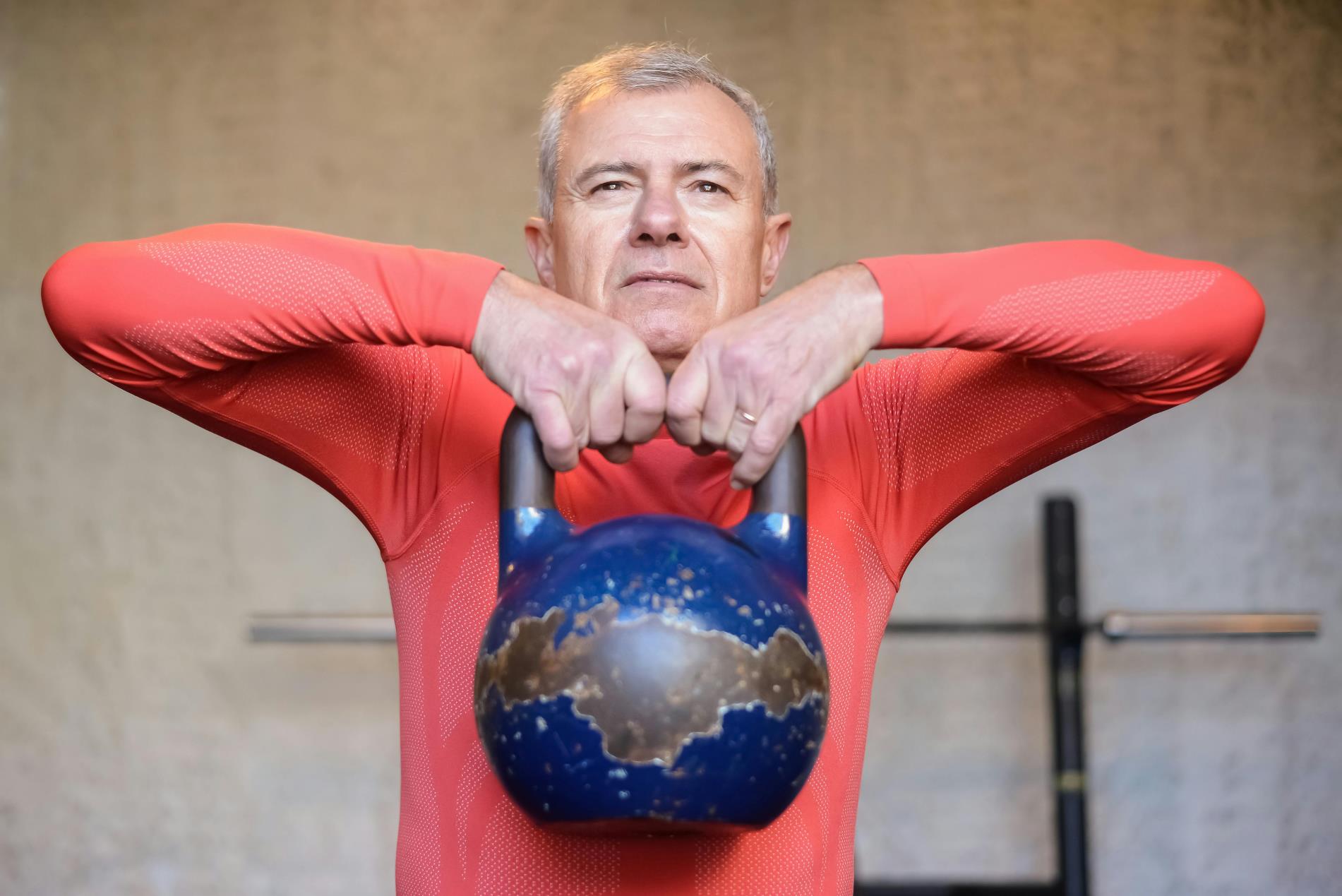
Photo by Kampus Production
This website uses affiliate links which may earn a commission at no additional cost to you. As an Amazon Associate I earn from qualifying purchases. which may cover part of a cup of coffee for me to fuel my training.
